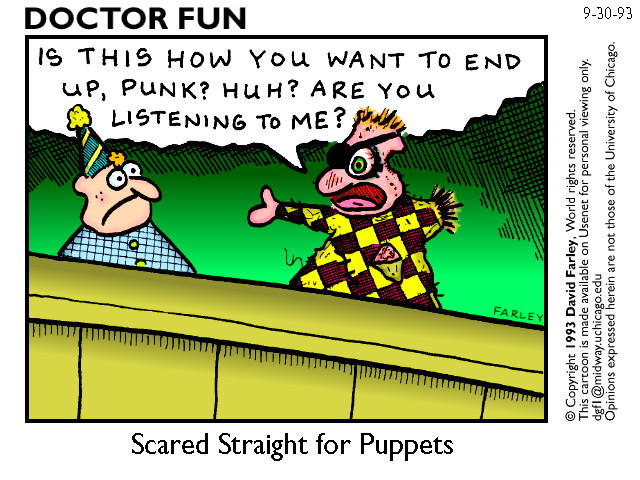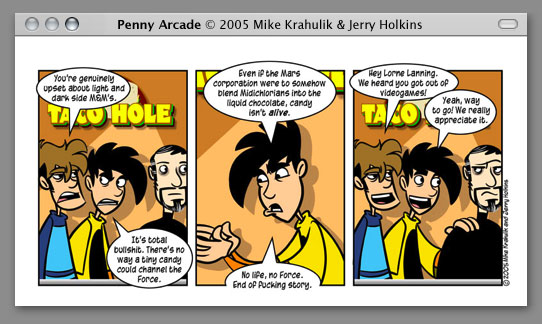The Doctor is In: Webcomics Not the Future
On alternating Tuesdays, Allan “Doc” Dorison operates on a specific part of popular culture.
by Allan Dorison
Considering the title of this essay, I feel like I have to defend myself before I can even begin.
First off, I’m a huge technology nerd. My first computer was an Amiga. I remember being the first person on my block to have Prodigy (a precursor to AOL). While hanging out at Rutgers I used to spend all night on the boards – way before chat rooms were a common way of life. Technology is a huge part of my day-to-day existence. As an audio/visual manager for an investment bank, I’ve seen the best and worst of what tech has to offer. In my apartment, I have almost totally done away with hard media. For movies, I watch streaming video. For music, iTunes. But, I still buy and fill my shelves with printed comic books. If I’m such a techie then why do I feel such an aversion to webcomics?
Before I go any further, let’s start off with a brief history of webcomics:

In September 1993, the first web comic was introduced. Doctor Fun by David Farley, ran from 1993 until 2006, completing 520 weeks (10 years) of strips.
Soon, people were beginning to realize the freedom that the World Wide Web offered to comic creators. During this time, a webcomics hosting provider named Big Panda was started by Bryan McNett. It hosted several early web comics, the most popular of which was Sluggy Freelance, which began in August 25, 1997. While its hosting services soon went on the decline, McNett also started a web comics portal. As T Campbell has stated, “Big Panda became a true web comics hub, with over 770 cartoonists vying for space on its homepage.”

Two of today’s most financially and popularly successful webcomics began in 1998. PvP by Scott Kurtz, began on May 4, and its gaming counterpart Penny Arcade by Jerry Holkins and Mike Krahulik, began on November 18.
Two big things happened for webcomics in 2000. The first was the first publication of MegaTokyo by Fred Gallagher and Rodney Caston, in August 14th . The second was the publication of noted comics scholar Scott McCloud’s Reinventing Comics on July 25th, a follow up to his immensely popular and educational Understanding Comics
from 1993. Things skyrocketed from there.
Now, on to my thoughts:
Comics were meant for the printed page. There is something very real about comics unlike movies and music. The smell of fresh ink brings back childhood memories of sitting with my dad and reading. The sound the spine makes when you first crack a new comic open. Even the texture of a comic. If you get a comic from the ’60s, ’70s, or ’80s, they feel a little like sandpaper. As you get into ’90s and today they feel like a slick Corvette. All this without even reading a single word.
There is no sense of ownership or pride when reading a webcomic. You can’t collect it, bag it, board it or display it to show off to your friends. You can’t bring a webcomic into the bathroom, or sneak them behind a text book in class. Web comics won’t go up in value or have variant covers that are hard to find. You can’t swap them with your friends or make copies of them with Silly Putty. Sitting if front of a computer for long periods of time causes headaches. Imagine trying to read Watchmen in front of a bright computer screen. I couldn’t do it.
Don’t get me wrong, I’m not a total hater. I frequently read Sub-Human, C’est La Vie, and The Amazing Adventures of Bill. They allow young upcoming artists and writers show their work at a relatively low to no cost. It also allows readers to read a daily strip and not wait a month for issues to come out. Considering the evolution of media and technology, webcomics are a major part of today’s comics scene and they are here to stay, but they can never completely replace the physical medium. They are not the future.
I have seen the future, and smelled it, and touched it, and it looks a lot like the next issue of Batman, or the next Neil Gaiman paperback that I buy from a comic shop or bookstore.
Allan Dorison is the event and conference manager for a major financial bank in New York City. He has previously served in a leadership capacity on the executive boards of several comics based organizations. His video parodies of pop culture phenomena can be found at http://www.youtube.com/user/hexo66.



I read webcomics in the bathroom all the time. It’s called an iPod Touch and its the way of the future. Still, yeah, I know what you mean. You see a comic book creator at a convention and you want to talk about how great the stories are and you want their autograph on your book. See a webcomic creator and you just casually chat with them about pop culture before going off to do something more exciting. I love webcomics peeps, but they’re two very different scenes.
Separate “scenes” maybe, but its still the same medium. Interestingly enough, the webcomics scene is constantly hacking its way into the print scene – probably to take part in that creator exchange that you mention Derrick, but also to make some money – which not a lot of webcomics do on their own. I think that as long as the popular webcomics make the transition to print in order to take advantage of the financial and “love” boons of their originally-in-print counterparts, the predictions of their eventual coup and their status as the “new conveyor” of the medium are completely marginalized.